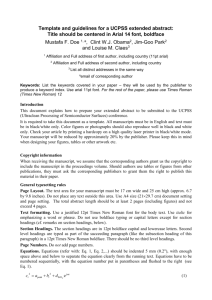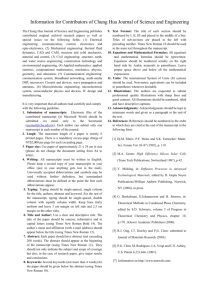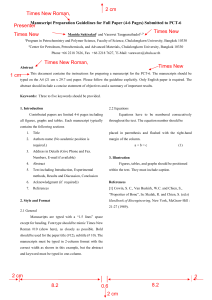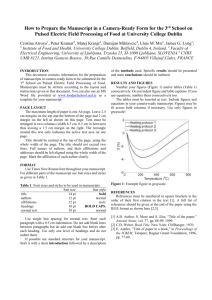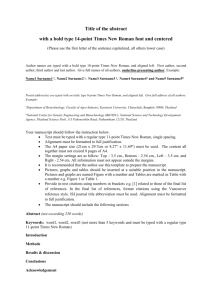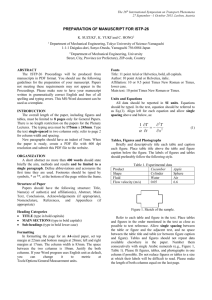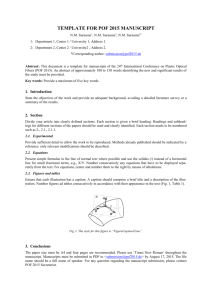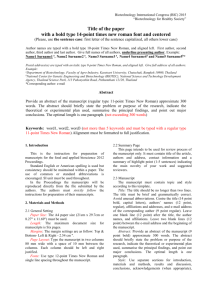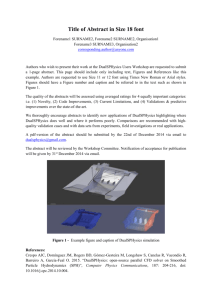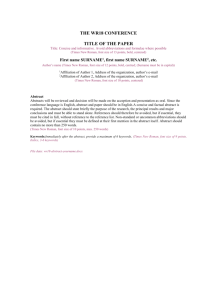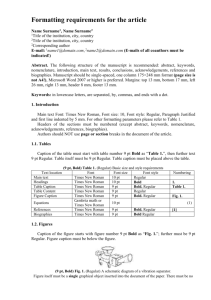Full Paper templates() - TJ
advertisement
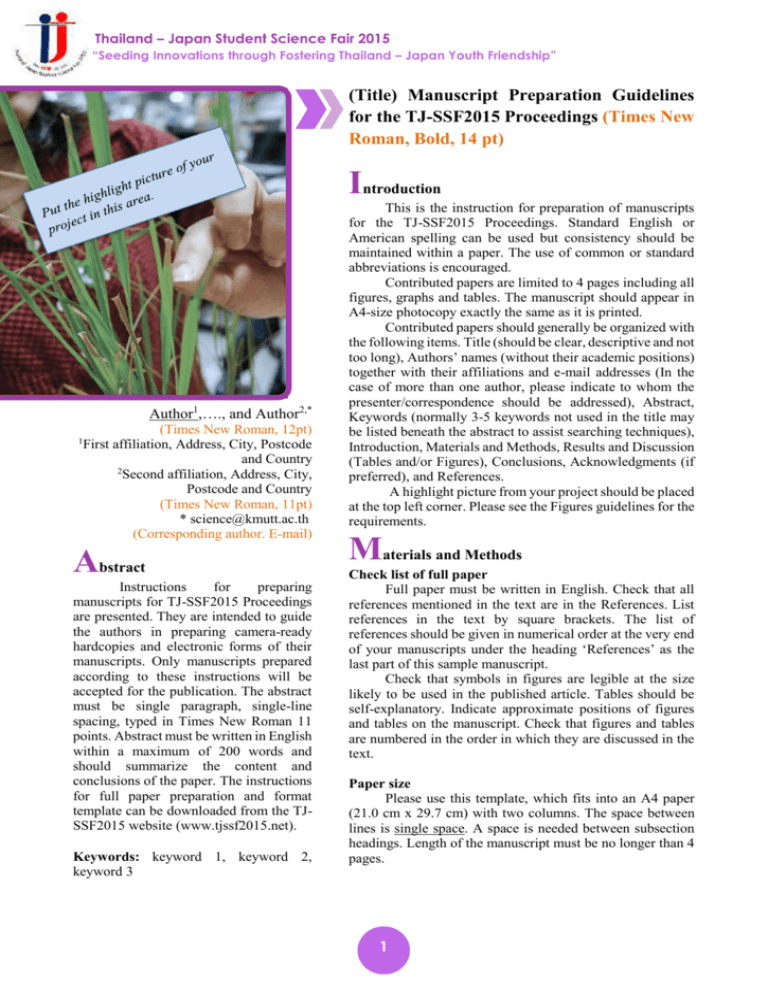
Thailand – Japan Student Science Fair 2015 “Seeding Innovations through Fostering Thailand – Japan Youth Friendship” (Title) Manuscript Preparation Guidelines for the TJ-SSF2015 Proceedings (Times New Roman, Bold, 14 pt) Introduction Author1,…., and Author2,* 1 (Times New Roman, 12pt) First affiliation, Address, City, Postcode and Country 2 Second affiliation, Address, City, Postcode and Country (Times New Roman, 11pt) * science@kmutt.ac.th (Corresponding author. E-mail) Abstract Instructions for preparing manuscripts for TJ-SSF2015 Proceedings are presented. They are intended to guide the authors in preparing camera-ready hardcopies and electronic forms of their manuscripts. Only manuscripts prepared according to these instructions will be accepted for the publication. The abstract must be single paragraph, single-line spacing, typed in Times New Roman 11 points. Abstract must be written in English within a maximum of 200 words and should summarize the content and conclusions of the paper. The instructions for full paper preparation and format template can be downloaded from the TJSSF2015 website (www.tjssf2015.net). Keywords: keyword 1, keyword 2, keyword 3 This is the instruction for preparation of manuscripts for the TJ-SSF2015 Proceedings. Standard English or American spelling can be used but consistency should be maintained within a paper. The use of common or standard abbreviations is encouraged. Contributed papers are limited to 4 pages including all figures, graphs and tables. The manuscript should appear in A4-size photocopy exactly the same as it is printed. Contributed papers should generally be organized with the following items. Title (should be clear, descriptive and not too long), Authors’ names (without their academic positions) together with their affiliations and e-mail addresses (In the case of more than one author, please indicate to whom the presenter/correspondence should be addressed), Abstract, Keywords (normally 3-5 keywords not used in the title may be listed beneath the abstract to assist searching techniques), Introduction, Materials and Methods, Results and Discussion (Tables and/or Figures), Conclusions, Acknowledgments (if preferred), and References. A highlight picture from your project should be placed at the top left corner. Please see the Figures guidelines for the requirements. Materials and Methods Check list of full paper Full paper must be written in English. Check that all references mentioned in the text are in the References. List references in the text by square brackets. The list of references should be given in numerical order at the very end of your manuscripts under the heading ‘References’ as the last part of this sample manuscript. Check that symbols in figures are legible at the size likely to be used in the published article. Tables should be self-explanatory. Indicate approximate positions of figures and tables on the manuscript. Check that figures and tables are numbered in the order in which they are discussed in the text. Paper size Please use this template, which fits into an A4 paper (21.0 cm x 29.7 cm) with two columns. The space between lines is single space. A space is needed between subsection headings. Length of the manuscript must be no longer than 4 pages. 1 Font type and sizes Only Times New Roman font is accepted in manuscript. Main headings (Introduction, Materials and Methods, Results and Discussion, Conclusions, Acknowledgments, References) are set in bold roman (12 points) type at the left of a column. Minor headings are set in bold roman (11 points). A regular 11 point size must be used throughout the context. Start a new paragraph by indenting it from the left margin by 7 mm (not by using multiple empty spaces) Table 1: Font Sizes and Styles Item Font Font Style Size Title 14 Bold, Capitals Equations and chemical formulae Equations should be numbered serially at the right-hand side in parentheses. In general, only equations explicitly referred to in the text need being numbered. Leave a blank line before and after an equation. V V V ij ij ij 2 1 2 1 2 1 i i i j j j i i i j j j (1) (2) (3) Chemical formulae should be typewritten, if possible. Subscripts and superscripts should be clear. Take special care to show clearly the difference between zero (0) and the letter O, and between one (1) and the letter 1. For simple fractions use the solidus (/) instead of a horizontal line. Author’s names 12 Regular Affiliations, addresses, email addresses 11 Italic Abstract 11 Regular SectionHeadings 12 Bold with a purple 28-point first character Sub-Section Headings 11 Bold Body Text 11 Regular References 11 Regular Figures Paste figures where needed (after and as close as possible to where they are mentioned in the text), if necessary spanning both columns. Number them consecutively using Arabic numbers (e.g. Figure 1, Figure 2) and provide a caption for each figure. Results and Discussion Tables Paste tables where needed (after and as close as possible to where they are mentioned in the text). Tables should be numbered according to their sequence in the text using Arabic numbers (e.g. Table 1, Table 2) and provide a caption for each table. Place caption above the table. Vertical lines should not be used to separate columns. Leave some extra space between the columns instead. Any explanation essential to the understanding of the table should be given as a footnote at the bottom of the table. Font sizes and styles to be used in the manuscript are summarized in Table 1. Figure 1. This is the Style for Figure Captions. Center this if it is not more than one line. Place caption beneath the figure. Leave one blank line before, and one after the caption. Do not indent or center the caption unless it contains 2 Thailand – Japan Student Science Fair 2015 “Seeding Innovations through Fostering Thailand – Japan Youth Friendship” only one line. Colored or black-and-white illustrations or graphics are acceptable. Photographs should be submitted and scanned as high quality. Do not submit poor-quality photocopies. If you use half tone (gray-scale) illustration, please keep in mind that there will be some loss in quality during the reproduction. [3.] R. Saito, G. Dresselhaus, and M. S. Dresselhaus, “Physical Properties of Carbon Nanotubes”, London, Imperial College Press, 1998. [4.] R. A. Bertlmann and A. Zeilinger (eds.), Quantum [Un]speakables, From Bell to Quantum Information, Berlin, SpringerVerlag, 2002. Figure 2. Captions center this if it is in one line. Conclusions The manuscript should be checked by all the co-authors prior to the submission, if possible, to eliminate error(s) that may escape your review. All submissions to TJ-SSF2015 proceedings should proceed online before the deadline (30 Sept. 2015) at the conference web site http://www.tjssf2015.net. Acknowledgments In acknowledgement you may thank all the people/organizations who provided their assistance to you in forms of advice, suggestions, and any others. References [1.] L. FÖrster, M. Karski, J. M. Choi, A. Steffen, W. Alt, D. Meschede, A. Widera, E. Montano, J. H. Lee, W. Rakreungdet, and P. S. Jessen, “Microwave Control of Atomic Motion in Optical Lattices”, Physical Review Letter 103 (2009), 233001. [2.] J. R. Anglin and W. Ketterle, “Bose-Einstein Condensation of Atomic Gases”, Nature 476 (2002) 211. 3
